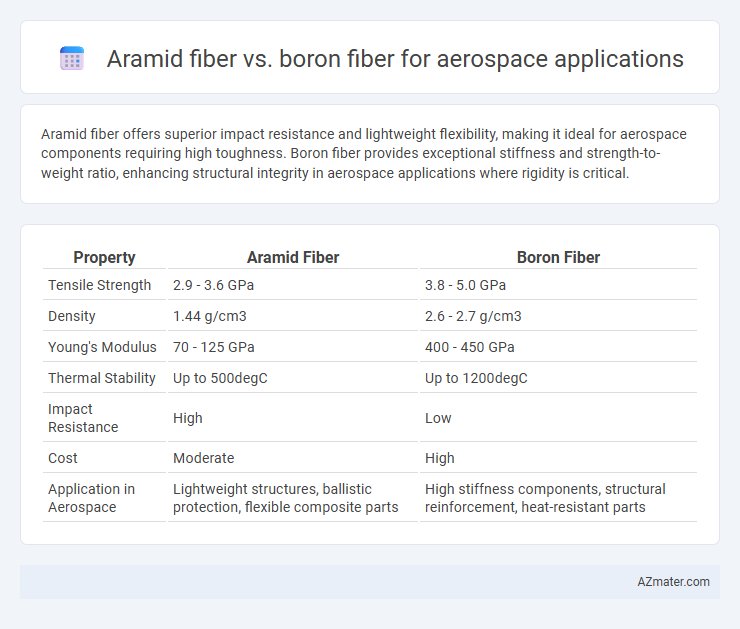Aramid fiber offers superior impact resistance and lightweight flexibility, making it ideal for aerospace components requiring high toughness. Boron fiber provides exceptional stiffness and strength-to-weight ratio, enhancing structural integrity in aerospace applications where rigidity is critical.
Table of Comparison
| Property | Aramid Fiber | Boron Fiber |
|---|---|---|
| Tensile Strength | 2.9 - 3.6 GPa | 3.8 - 5.0 GPa |
| Density | 1.44 g/cm3 | 2.6 - 2.7 g/cm3 |
| Young's Modulus | 70 - 125 GPa | 400 - 450 GPa |
| Thermal Stability | Up to 500degC | Up to 1200degC |
| Impact Resistance | High | Low |
| Cost | Moderate | High |
| Application in Aerospace | Lightweight structures, ballistic protection, flexible composite parts | High stiffness components, structural reinforcement, heat-resistant parts |
Introduction to Advanced Aerospace Fibers
Aramid fiber and boron fiber are advanced aerospace materials known for their exceptional strength-to-weight ratios and thermal resistance, critical in high-performance aerospace applications. Aramid fibers, such as Kevlar, offer high impact resistance and flexibility, making them ideal for protective components and lightweight structural applications. Boron fibers provide superior stiffness and compressive strength, often used in primary aircraft structures and space vehicles where rigidity and load-bearing capacity are paramount.
Overview of Aramid Fiber Properties
Aramid fiber exhibits exceptional tensile strength, lightweight characteristics, and outstanding impact resistance, making it ideal for aerospace applications requiring durability and flexibility. Its high heat resistance and excellent vibration damping properties enhance safety and comfort in aircraft components exposed to extreme conditions. Unlike boron fiber, aramid fiber offers superior toughness and lower density, contributing to improved fuel efficiency and structural integrity in aerospace designs.
Key Characteristics of Boron Fiber
Boron fiber features exceptional tensile strength of approximately 4,140 MPa and a high modulus nearing 380 GPa, making it ideal for aerospace structures demanding superior stiffness and load-bearing capacity. Its lightweight nature, with a density around 2.6 g/cm3, combined with excellent thermal stability and resistance to fatigue, enhances performance in high-temperature, high-stress aerospace environments. Boron fiber's affinity for carbon matrix bonding improves composite material integrity, offering significant advantages over aramid fiber in applications requiring rigidity and dimensional stability.
Mechanical Strength Comparison: Aramid vs Boron
Aramid fibers, such as Kevlar, exhibit high tensile strength around 3.6 GPa combined with excellent impact resistance and flexibility, making them ideal for aerospace components needing energy absorption and durability. Boron fibers, with tensile strengths exceeding 3.7 GPa and superior stiffness (modulus up to 400 GPa), provide exceptional load-bearing capacity and rigidity crucial for structural aerospace parts. While boron fibers offer higher mechanical strength and modulus compared to aramid fibers, their brittleness and cost limit their use to specialized aerospace applications requiring maximal strength-to-weight ratios.
Weight and Density Considerations
Aramid fiber exhibits a density of approximately 1.44 g/cm3, making it significantly lighter than boron fiber, which has a density near 2.52 g/cm3, a critical factor in aerospace structures where weight reduction enhances fuel efficiency and payload capacity. The lower density of aramid fibers contributes to superior weight savings without compromising tensile strength, whereas boron fibers, though heavier, offer higher stiffness and modulus, impacting design choices based on performance requirements. Selecting between aramid and boron fibers necessitates balancing the trade-off between weight-driven efficiency and the mechanical rigidity essential for aerospace component durability.
Thermal Stability and Environmental Resistance
Aramid fiber exhibits excellent thermal stability with decomposition temperatures around 500degC, making it suitable for aerospace applications requiring high heat resistance, while boron fiber offers superior thermal stability up to 900degC, enabling performance in extreme temperature environments. In terms of environmental resistance, aramid fibers provide good resistance to moisture and chemicals but degrade under UV exposure, whereas boron fibers demonstrate outstanding resistance to corrosion and oxidation, maintaining mechanical properties in harsh aerospace conditions. The choice between aramid and boron fibers depends on specific aerospace requirements for temperature endurance and durability against environmental stressors.
Fatigue and Impact Performance
Aramid fiber exhibits superior impact resistance and energy absorption due to its high toughness, making it ideal for aerospace components subjected to dynamic loads. Boron fiber offers exceptional fatigue life and stiffness, providing enhanced durability in cyclic loading conditions common in aircraft structures. The choice between aramid and boron fibers hinges on balancing fatigue performance with impact tolerance specific to aerospace mission profiles.
Cost and Manufacturing Challenges
Aramid fiber offers a lower-cost alternative to boron fiber, making it more accessible for large-scale aerospace applications despite slightly inferior stiffness and strength. Boron fiber, while providing superior tensile strength and stiffness, presents significant manufacturing challenges due to its brittleness and higher processing costs, limiting its use to specialized structural components. The choice between aramid and boron fiber in aerospace hinges on balancing cost-efficiency against performance requirements and fabrication complexity.
Typical Aerospace Applications of Aramid and Boron Fibers
Aramid fibers are extensively used in aerospace for impact-resistant components such as helicopter rotor blades, ballistic armor, and aircraft interiors due to their high toughness and excellent energy absorption. Boron fibers find typical aerospace applications in high-modulus structural components, including aircraft wing spars and stiffened panels, where superior stiffness and strength-to-weight ratio are critical. Both fibers contribute to reducing aircraft weight while enhancing performance and safety, with aramid fibers favored for durability and boron fibers for rigidity.
Future Trends in Aerospace Fiber Technologies
Aramid fiber and boron fiber both play crucial roles in aerospace applications due to their high strength-to-weight ratios and thermal stability. Future trends indicate increased integration of hybrid composites combining aramid fiber's excellent impact resistance with boron fiber's superior stiffness and fatigue resistance for enhanced performance. Advancements in nanotechnology and fiber surface treatments are expected to further improve bonding, durability, and multifunctionality in aerospace fiber-reinforced components.

Infographic: Aramid fiber vs Boron fiber for Aerospace application
 azmater.com
azmater.com